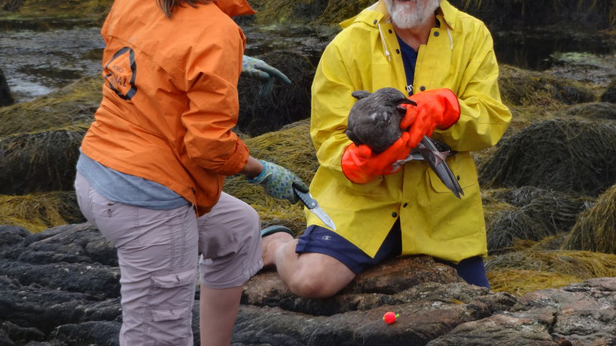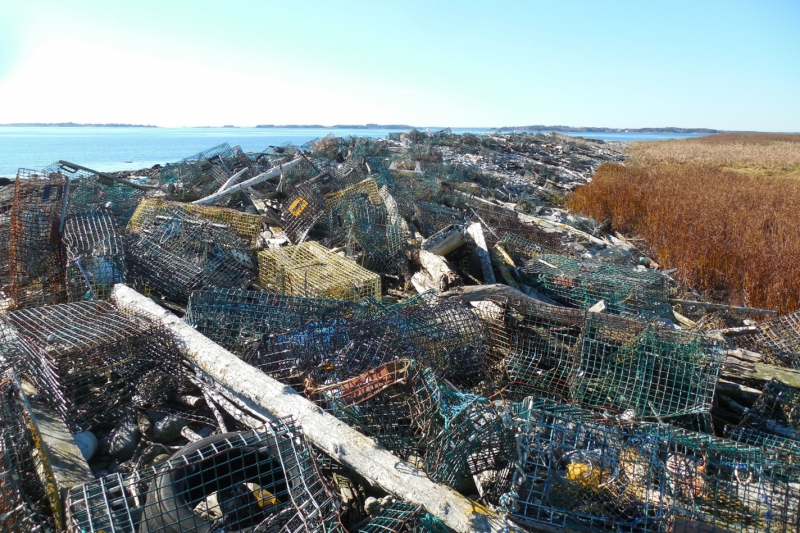Guest blog by: Michael Andranovich, University of Rhode Island Graduate Student/United States Fish and Wildlife Service Research Assistant
Marine debris is widely recognized as a threat to coastal and marine wildlife. In the Northeastern United States, however, the severity and magnitude of the impacts of marine debris on birds has not been well evaluated. In recent years, the NOAA Marine Debris Program (MDP) has coordinated the development of the Gulf of Maine Marine Debris Action Plan in its Northeast region, in partnership with the United States Fish and Wildlife Service (USFWS) and dozens of other agencies and organizations. My current position as a USFWS research assistant was created from a major strategy identified in the five-year plan to assess marine debris risks to wildlife and habitat. With this in mind, the USFWS, which has regulatory responsibility for all listed bird species in the Migratory Bird Treaty Act and Endangered Species Act, aimed to conduct research to better understand the effects of marine debris on birds.

The project, funded jointly by the MDP and USFWS, began in May 2020 with the goal of creating a report for the Gulf of Maine region that identifies marine debris threats to birds, the information gaps for better understanding of impacts, and broad strategies to address specific threats. The report’s ultimate aim is to help guide future research and projects to minimize adverse effects of marine debris to birds. Information for the report was generated through a review of published literature and technical reports, as well as the documented experiences of a wide range of partners from multiple professions that work directly with marine debris or birds. When asked how researchers and seabird managers could better understand the unknown severity of impacts of marine debris on seabirds, most stakeholders in the Gulf of Maine region highlighted the need to identify actual sources (both on land and at sea) of marine debris, and conduct research to find accurate estimates of birds affected by marine debris at regional, community, and population levels. It’s important to create a final product that is useful not only for researchers and managers, but for the general public as well. It’s going to take all community members’ effort to combat marine debris!

At this time, the results show that the most prominent types of marine debris in the Northeast region include derelict fishing gear, described as recreational or commercial fishing nets, lines, pots, and traps lost in the environment, and consumer litter, which includes plastic bottles and caps, balloons, household garbage, cigarettes, and various other man-made items that we use on a daily basis. The Gulf of Maine and its surrounding waters support a large, successful lobster and fishing industry, resulting in a substantial amount of gear in the water, which can be lost due to irregular ocean floor topography, adverse weather, and misplacement. The region also supports a thriving tourist and recreation industry, thanks to its picturesque beaches, rocky coastlines, and abundant inland forests. During peak summer months, the increase in visitors generates greater amounts of consumer waste, which has the potential to become litter and end up as marine debris if not properly disposed of.
The impacts of marine debris on birds can be grouped into three general categories: entanglement, ingestion, and alteration of nesting habitat. Seabird entanglement in marine debris can result in cuts and abrasions to skin, impeded mobility, which increases the risk of starvation and predation, and drowning. Ingestion of marine debris by seabirds can lead to physical damage and blockage of the digestive tract, absorption of toxic chemicals, and decreased efficiency in the ability to find food. Nesting habitat of seabirds can also be affected when birds use marine debris in nests, not only increasing the chances of entanglement and ingestion, but also increasing predation due to the presence of food-related debris, which can attract predators.
A final report on the impacts of marine debris to birds in the Northeast will be released in Summer 2021.


I have many reasons to read all you have as I run a Maritime Museum in Maine and am on the Zero Waster Committee with a special interest in ocean health. I am also committed to learning how to best recycle fiberglass boats.